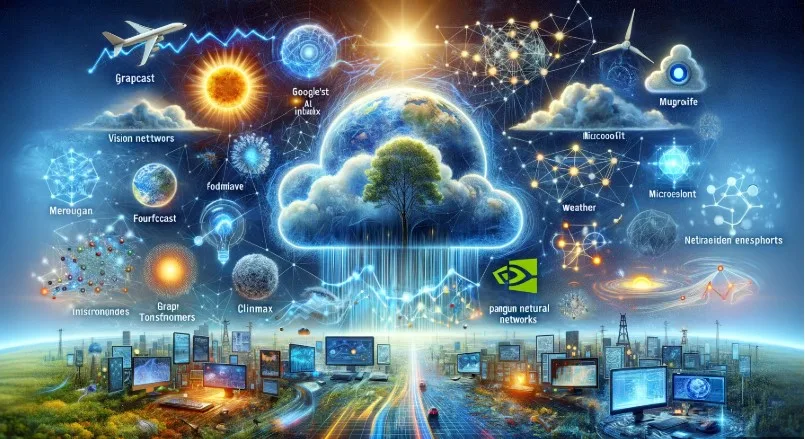AI Is Revolutionizing :The ability to predict rainfall accurately, especially in the short term, is invaluable. Whether planning outdoor events, managing city infrastructure, or simply deciding whether to carry an umbrella, knowing what the sky has in store can make a significant difference. Recent advancements in AI are making it possible to predict rainfall with unprecedented accuracy, offering a glimpse into a future where weather forecasts are more precise and timely than ever before.
The Institute for Climate Change Studies (ICCS) has developed an AI-based system called ‘Eye in the Sky’. This system is designed to provide real-time rainfall predictions up to two hours in advance. While the system’s development took place in Kottayam, India, the impact of such technology is global.
Understanding Nowcasting and Its Benefits
Nowcasting focuses on short-term weather forecasting, typically spanning from a few minutes to a couple of hours. This is where AI excels, overcoming the limitations of traditional weather prediction models. Traditional models often struggle with the speed and high resolution required for immediate forecasts.
How ‘Eye in the Sky’ Works
The ‘Eye in the Sky’ system relies on processing vast amounts of data from various sources in real-time. Here’s how it works:
- Radar and Satellite Data: The system uses weather radar images to gather data about existing rain, clouds, and atmospheric movements.
- Machine Learning: AI models, such as Convolutional Neural Networks (CNNs) and Recurrent Neural Networks (RNNs), are trained on historical data. They learn patterns that predict rainfall.
- Predictive Modeling: The system uses these learned patterns to forecast future rainfall, including intensity and location, up to two hours in advance.
AI Techniques in Rainfall Prediction
AI uses advanced algorithms and statistical models to predict rainfall patterns with greater accuracy than traditional methods.
- Machine Learning (ML): ML algorithms identify patterns and make predictions from historical data. Regression models predict rainfall amounts, while classification algorithms determine if it will rain.
- Neural Networks: Inspired by the human brain, these algorithms can learn complex relationships in weather data.
- Deep Learning (DL): DL uses multi-layered neural networks for a more sophisticated analysis of weather data, identifying subtle patterns.
Long Short-Term Memory (LSTM) networks are well-suited for nowcasting. LSTMs handle sequential data, like weather patterns over time. They “remember” past information to inform future predictions. For example, an LSTM could learn how a particular atmospheric pressure reading, combined with a specific wind direction, can lead to a heavy downpour in a certain area.
Impact and Applications
This advanced rainfall prediction system offers many benefits.
- Disaster Preparedness: Timely alerts can give emergency services and residents time to prepare for potential flooding or landslides. This is particularly helpful in flood-prone areas.
- Agriculture: Farmers can optimize irrigation schedules.
- Urban Planning: Cities can proactively manage drainage systems.
- Transportation: Improved predictions can help pilots navigate storms and minimize delays.
- Outdoor Events: Event organizers can make informed decisions about events.
More Ways AI Can Improve Forecasts
The potential of AI in rainfall prediction goes beyond delivering a more accurate forecast.
- Tailored Advisories: AI can provide insights into rainfall characteristics, such as the duration or intensity of the rain.
- Integrating with Smart Infrastructure: AI-powered sensors could adjust traffic signals during downpours or smart irrigation systems could adjust watering schedules. NOAA’s HRRR-Cast system in the US explores similar applications.
Challenges and Considerations
While AI offers many advantages, it’s not without challenges.
- Data Quality: AI models need large, high-quality datasets.
- Computational Demands: Training deep learning models requires significant computing power.
- Interpretability: Understanding how deep learning models make predictions can be difficult.
AI-powered forecasting complements traditional weather forecasting. Traditional methods use physical equations governing atmospheric dynamics. AI excels at pattern recognition and data analysis. The most effective approach will likely combine both AI and traditional models.

The Future of Rainfall Prediction
The development of systems like ‘Eye in the Sky’ represents a step forward in weather prediction. As AI technology advances, we can expect more refined and localized rainfall forecasts. This revolution in nowcasting promises to enable better decisions and prepare for a changing climate. The future of weather prediction is looking clearer and more precise.

